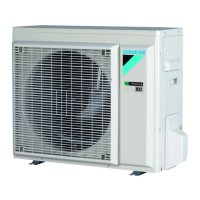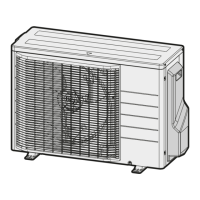Do you have a question about the Daikin RXM20A5V1B and is the answer not in the manual?
Details the scope, target audience, and structure of the installer reference guide.
Explains the different warning symbols and their meanings used throughout the manual.
Covers essential safety information for installers, including general warnings and specific risks.
Details safe practices and conditions for selecting and preparing the installation location.
Addresses specific safety concerns and procedures when handling R32 refrigerant.
Outlines crucial safety measures for electrical connections and wiring.
Safety guidelines for handling, site preparation, unit installation, opening, and piping.
Safety measures for refrigerant charging, electrical work, configuration, and commissioning.
Safety protocols for maintenance, troubleshooting, and compressor servicing.
Step-by-step instructions for safely unpacking the outdoor unit from its packaging.
Guidelines and precautions for transporting and manipulating the outdoor unit.
Procedure for locating and removing accessories packed with the outdoor unit.
Guidance on selecting and preparing a suitable location for unit installation.
Specific requirements and spacing guidelines for outdoor unit placement.
Additional site preparation needs for installation in cold weather conditions.
Procedures and safety precautions for physically mounting the outdoor unit.
Instructions for setting up proper drainage for condensate water.
Measures to secure the unit against tilting or falling due to strong winds.
Requirements for refrigerant piping materials, dimensions, and insulation.
Detailed steps and precautions for connecting refrigerant piping.
Procedures for leak testing and vacuum drying of the refrigerant piping.
Overview of the process and necessity for adding refrigerant.
Information about the refrigerant type, properties, and safety warnings.
Method for calculating the required amount of additional refrigerant.
Step-by-step guide for adding the calculated amount of refrigerant.
Instructions for applying the required label indicating refrigerant quantity.
Guidelines and precautions for connecting the unit's electrical wiring.
Details on power supply, cables, circuit breakers, and other electrical components.
Specific procedures for connecting electrical wiring to the outdoor unit.
Final steps to complete the outdoor unit installation, including insulation.
Procedure for securely closing the outdoor unit covers after installation.
Instructions for enabling facility mode for low-temperature cooling operations.
Guide to activating the standby electricity saving mode for reduced power consumption.
Safety measures and critical checks required before and during commissioning.
Lists of items to verify before and during the unit commissioning process.
Procedure for conducting an initial test run to verify unit operation.
Final steps for powering up and starting the outdoor unit.
Ensuring the user has the manual and understands basic operation.
Providing guidance on unit maintenance and tips for energy efficiency.
Introduction to the maintenance procedures and service information.
Safety guidelines to follow when performing maintenance tasks.
A checklist of items for annual inspection and cleaning of the outdoor unit.
Specific precautions and procedures for servicing the compressor.
Introduction to the troubleshooting section and problem-solving approach.
Safety measures to observe when diagnosing and repairing unit faults.
Guides for diagnosing and resolving issues based on observed symptoms.
Interpreting outdoor unit LED indicators to diagnose operational faults.
General information and legal requirements for proper unit disposal.
Steps for safely removing refrigerant from the system before disposal or relocation.
Methods for initiating and stopping forced cooling operations.
Explanation of symbols and codes used in electrical wiring diagrams.
Diagram illustrating the refrigerant piping layout and components.
Definitions of key technical terms and acronyms used in the manual.
Details the scope, target audience, and structure of the installer reference guide.
Explains the different warning symbols and their meanings used throughout the manual.
Covers essential safety information for installers, including general warnings and specific risks.
Details safe practices and conditions for selecting and preparing the installation location.
Addresses specific safety concerns and procedures when handling R32 refrigerant.
Outlines crucial safety measures for electrical connections and wiring.
Safety guidelines for handling, site preparation, unit installation, opening, and piping.
Safety measures for refrigerant charging, electrical work, configuration, and commissioning.
Safety protocols for maintenance, troubleshooting, and compressor servicing.
Step-by-step instructions for safely unpacking the outdoor unit from its packaging.
Guidelines and precautions for transporting and manipulating the outdoor unit.
Procedure for locating and removing accessories packed with the outdoor unit.
Guidance on selecting and preparing a suitable location for unit installation.
Specific requirements and spacing guidelines for outdoor unit placement.
Additional site preparation needs for installation in cold weather conditions.
Procedures and safety precautions for physically mounting the outdoor unit.
Instructions for setting up proper drainage for condensate water.
Measures to secure the unit against tilting or falling due to strong winds.
Requirements for refrigerant piping materials, dimensions, and insulation.
Detailed steps and precautions for connecting refrigerant piping.
Procedures for leak testing and vacuum drying of the refrigerant piping.
Overview of the process and necessity for adding refrigerant.
Information about the refrigerant type, properties, and safety warnings.
Method for calculating the required amount of additional refrigerant.
Step-by-step guide for adding the calculated amount of refrigerant.
Instructions for applying the required label indicating refrigerant quantity.
Guidelines and precautions for connecting the unit's electrical wiring.
Details on power supply, cables, circuit breakers, and other electrical components.
Specific procedures for connecting electrical wiring to the outdoor unit.
Final steps to complete the outdoor unit installation, including insulation.
Procedure for securely closing the outdoor unit covers after installation.
Instructions for enabling facility mode for low-temperature cooling operations.
Guide to activating the standby electricity saving mode for reduced power consumption.
Safety measures and critical checks required before and during commissioning.
Lists of items to verify before and during the unit commissioning process.
Procedure for conducting an initial test run to verify unit operation.
Final steps for powering up and starting the outdoor unit.
Ensuring the user has the manual and understands basic operation.
Providing guidance on unit maintenance and tips for energy efficiency.
Introduction to the maintenance procedures and service information.
Safety guidelines to follow when performing maintenance tasks.
A checklist of items for annual inspection and cleaning of the outdoor unit.
Specific precautions and procedures for servicing the compressor.
Introduction to the troubleshooting section and problem-solving approach.
Safety measures to observe when diagnosing and repairing unit faults.
Guides for diagnosing and resolving issues based on observed symptoms.
Interpreting outdoor unit LED indicators to diagnose operational faults.
General information and legal requirements for proper unit disposal.
Steps for safely removing refrigerant from the system before disposal or relocation.
Methods for initiating and stopping forced cooling operations.
Explanation of symbols and codes used in electrical wiring diagrams.
Diagram illustrating the refrigerant piping layout and components.
Definitions of key technical terms and acronyms used in the manual.
| Cooling Capacity | 2.0 kW |
|---|---|
| Refrigerant | R32 |
| Weight (Indoor Unit) | 9 kg |
| Noise Level (Outdoor) | 48 dB(A) |
| Inverter | Yes |
| Heating Capacity | 2.5 kW |
| Type | Split System |
| Power Supply | 220-240V/50Hz/1Phase |











